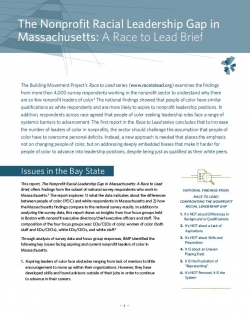The Nonprofit Racial Leadership Gap in Massachusetts: A Race to Lead Brief
The Nonprofit Racial Leadership Gap in Massachusetts: A Race to Lead Brief can be found at http://racetolead.org/massachusetts!
The Building Movement Project’s Race to Lead series examines the findings from more than 4,000 survey respondents working in the nonprofit sector to understand why there are so few nonprofit leaders of color. The national findings showed that people of color have similar qualifications as white respondents and are more likely to aspire to nonprofit leadership positions. In addition, respondents across race agreed that people of color seeking leadership roles face a range of systemic barriers to advancement. The first report in the Race to Lead series concludes that to increase the number of leaders of color in nonprofits, the sector should challenge the assumption that people of color have to overcome personal deficits. Instead, a new approach is needed that places the emphasis not on changing people of color, but on addressing deeply embedded biases that make it harder for people of color to advance into leadership positions, despite being just as qualified as their white peers.
This report, The Nonprofit Racial Leadership Gap in Massachusetts: A Race to Lead Brief, offers findings from the subset of national survey respondents who work in Massachusetts. The report explores: 1) what the data indicates about the differences between people of color (POC) and white respondents in Massachusetts and 2) how the Massachusetts findings compare to the national survey results. In addition to analyzing the survey data, this report draws on insights from four focus groups held in Boston with nonprofit executive directors/chief executive officers and staff. The composition of the four focus groups was: EDs/CEOs of color, women of color (both staff and EDs/CEOs), white EDs/CEOs, and white staff.3 Through analysis of survey data and focus group responses, BMP identified the following key issues facing aspiring and current nonprofit leaders of color in Massachusetts.
- Aspiring leaders of color face obstacles ranging from lack of mentors to little encouragement to move up within their organizations. However, they have developed skills and found advisors outside of their jobs in order to continue to advance in their careers.
- Top leaders in nonprofits need to be able to raise funds from public sources, foundations and donors who often have little understanding of—or contact with—the communities of color they are trying to support. Current and aspiring leaders of color who have more connection to community needs are frequently excluded from networks and relationships of wealth. As a result, people of color may be overlooked by funders, even though they are the leaders who could most effectively drive investments in underserved communities.
- People of color seeking leadership positions experience barriers from whitedominated boards and executive recruiters based on assumptions about their skill levels and concerns about their ability to raise funds. Aspiring leaders of color are rarely offered the opportunities and supports needed to be successful in top leadership roles, despite the expertise and skills they bring.
To learn more, download the full report, and check out our website, www.racetolead.org/massachusetts.

